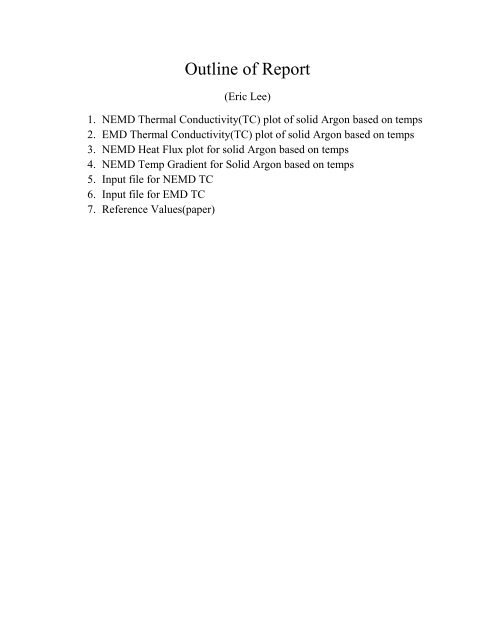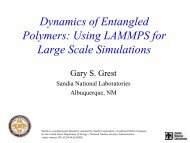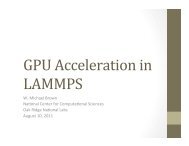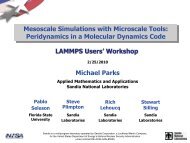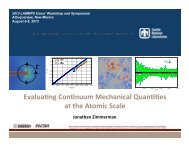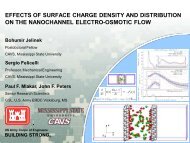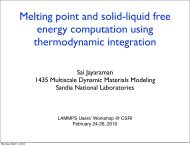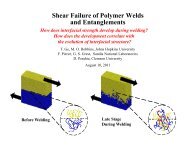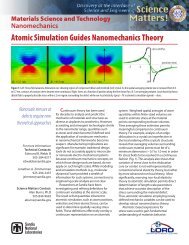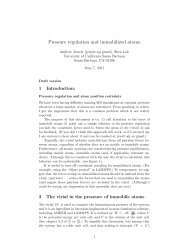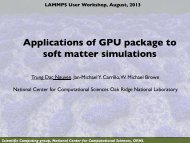Outline of Report - Lammps
Outline of Report - Lammps
Outline of Report - Lammps
You also want an ePaper? Increase the reach of your titles
YUMPU automatically turns print PDFs into web optimized ePapers that Google loves.
<strong>Outline</strong> <strong>of</strong> <strong>Report</strong><br />
(Eric Lee)<br />
1. NEMD Thermal Conductivity(TC) plot <strong>of</strong> solid Argon based on temps<br />
2. EMD Thermal Conductivity(TC) plot <strong>of</strong> solid Argon based on temps<br />
3. NEMD Heat Flux plot for solid Argon based on temps<br />
4. NEMD Temp Gradient for Solid Argon based on temps<br />
5. Input file for NEMD TC<br />
6. Input file for EMD TC<br />
7. Reference Values(paper)
Thermal Conductivity W/m-k<br />
1. Fig1 is the results <strong>of</strong> NEMD for calculating the thermal conductivity<br />
(TC) <strong>of</strong> Argon. Interestingly, the higher the temperature, the TC<br />
values goes higher, which is contrary to the reference value. I tried<br />
longer time steps <strong>of</strong> 80 million with step length 0.005. But the results<br />
still show the same trends.<br />
10 1 Heat Conductivity <strong>of</strong> solid Argon<br />
10 0<br />
10 -1<br />
10 -2<br />
10 -3<br />
NEMD04<br />
NEMD04v2<br />
NEMD05<br />
RefValue01<br />
RefValue02<br />
10 1 10 2<br />
Temprature K<br />
Fig 1 Thermal Conductivity <strong>of</strong> Argon based on NEMD for T=1~100
Thermal Conductivity W/m-k<br />
2. Fig2 is the results <strong>of</strong> EMD for calculating the thermal conductivity (TC)<br />
<strong>of</strong> Argon. Although the TC values go lower with temperature going higher,<br />
the TC values in lower temp region(T=1-20K) is still much smaller than the<br />
reference value. Also the time step is 80 million with step length 0.005.<br />
10 1 Heat Conductivity <strong>of</strong> solid Argon N=256 atoms<br />
MDvalue01<br />
RefValue01<br />
RefValue02<br />
MDvalue02<br />
MDvalue03<br />
10 0<br />
10 -1<br />
10 0 10 1 10 2<br />
Temprature K<br />
Fig 2 Thermal Conductivity <strong>of</strong> Argon based on EMD for T=1~100
Energy<br />
3. Fig3 is about the NEMD heat flux for different temperatures. As we can see<br />
some the heat flux is linear trend. But most others are a little curve.<br />
12 x 106 Energy transferred <strong>of</strong> solid Argon<br />
10<br />
8<br />
6<br />
T0.1<br />
T0.2<br />
T0.3<br />
T0.4<br />
T0.5<br />
T0.6<br />
T0.7<br />
T0.8<br />
4<br />
2<br />
0<br />
10 15 20 25 30 35 40 45 50 55 60<br />
Timstepsx1000000<br />
Fig 3 Heat Flux for NEMD based on temp T*=0.1~0.8.
Temp<br />
4. Fig4 is about the NEMD temp gradient for different temperatures. As we can<br />
see when T*=0.4 the temp gradient is linear trend. But most others are not.<br />
1.5<br />
Temp Pr<strong>of</strong>ile <strong>of</strong> solid Argon<br />
1<br />
T0.1<br />
T0.2<br />
T0.3<br />
T0.4<br />
T0.5<br />
T0.6<br />
T0.7<br />
T0.8<br />
0.5<br />
0<br />
2 4 6 8 10 12 14 16<br />
Slab bins<br />
Fig 4 Temp Gradient for NEMD based on temp T*=0.1~0.8.
5. Input files for NEMD<br />
# NEMD simulation <strong>of</strong> Ar thermal conductivity<br />
clear<br />
units lj<br />
log log.Ar03NEMDT0.8<br />
dimension 3<br />
newton on<br />
boundary p p p<br />
atom_style atomic<br />
neighbor 0.3 bin<br />
neigh_modify check yes<br />
lattice fcc 0.844<br />
region box block -4 4 -4 4 -4 4 units lattice<br />
create_box 1 box<br />
create_atoms 1 box<br />
mass 1 1.0<br />
velocity all create 0.8 458127641 mom yes rot yes dist gaussian units box<br />
pair_style lj/cut 2.8<br />
pair_coeff 1 1 1.0 1.0 # LJ parameters for Ar-Ar<br />
fix temp all temp/berendsen 0.8 0.8 0.02<br />
fix nve all nve<br />
compute ke all ke/atom<br />
variable temp atom c_ke/1.5<br />
fix temp_pr<strong>of</strong>ile all ave/spatial 1 1000000 1000000 z lower 0.5 v_temp file<br />
v3temp0.8.pr<strong>of</strong>ile units lattice # where i can get the temp gradient by dT/dz<br />
thermo_style custom step temp etotal vol press<br />
thermo_modify lost warn<br />
thermo 1000<br />
timestep 0.005<br />
run 1000001 # for equilibrium<br />
unfix temp<br />
fix heat_swap all thermal/conductivity 10 z 16<br />
fix e_exchange all ave/time 100 10000 1000000 f_heat_swap file v3e_exchange0.8.dat #<br />
where i get the heat flux by Q/A/t<br />
run 80000000<br />
# i can get the thermal conductivity by k=(Q/A/t)/(dT/dz).
6. Input files for EMD<br />
# Sample LAMMPS input script for thermal conductivity <strong>of</strong> solid Ar<br />
clear<br />
log<br />
log.ArEMDT30<br />
units real<br />
variable T equal 30<br />
variable V equal vol<br />
variable dt equal 5.0<br />
variable p equal 400 # correlation length<br />
variable s equal 10 # sample interval<br />
variable d equal $p*$s # dump interval<br />
# convert from LAMMPS real units to SI<br />
variable kB equal 1.3806504e-23 # [J/K] Boltzmann<br />
variable kCal2J equal 4186.0/6.02214e23<br />
variable A2m equal 1.0e-10<br />
variable fs2s equal 1.0e-15<br />
variable convert equal ${kCal2J}*${kCal2J}/${fs2s}/${A2m}<br />
# setup problem<br />
dimension 3<br />
boundary p p p<br />
lattice fcc 5.376 orient x 1 0 0 orient y 0 1 0 orient z 0 0 1<br />
region box block 0 4 0 4 0 4<br />
create_box 1 box<br />
create_atoms 1 box<br />
mass 1 39.948<br />
pair_style lj/cut 13.0<br />
pair_coeff * * 0.2381 3.405<br />
timestep ${dt}<br />
thermo $d<br />
# equilibration and thermalization<br />
velocity all create $T 102486 mom yes rot yes dist gaussian<br />
fix NVT all nvt temp $T $T 10 drag 0.2<br />
run 20000000<br />
# thermal conductivity calculation, switch to NVE if desired<br />
unfix NVT<br />
fix<br />
NVE all nve<br />
reset_timestep 0<br />
compute myKE all ke/atom<br />
compute myPE all pe/atom<br />
compute myStress all stress/atom virial<br />
compute flux all heat/flux myKE myPE myStress<br />
variable Jx equal c_flux[1]/vol<br />
variable Jy equal c_flux[2]/vol<br />
variable Jz equal c_flux[3]/vol<br />
fix<br />
JJ all ave/correlate $s $p $d &<br />
c_flux[1] c_flux[2] c_flux[3] type auto file J0JtT30.dat ave running<br />
variable scale equal ${convert}/${kB}/$T/$T/$V*$s*${dt}<br />
variable k11 equal trap(f_JJ[3])*${scale}<br />
variable k22 equal trap(f_JJ[4])*${scale}<br />
variable k33 equal trap(f_JJ[5])*${scale}<br />
thermo_style custom step temp v_Jx v_Jy v_Jz v_k11 v_k22 v_k33 press<br />
run 60000000<br />
variable k equal (v_k11+v_k22+v_k33)/3.0<br />
variable ndens equal count(all)/vol<br />
print "average conductivity: $k[W/mK] @ $T K, ${ndens} /A^3"
8. Reference<br />
[1]Thermal conductivity <strong>of</strong> solid Argon by classical Molecular Dynamics.<br />
Mater.Res.Soc.Symp.Proc.538(1999)503-8. Ju Li, Sidney Yip et.al


